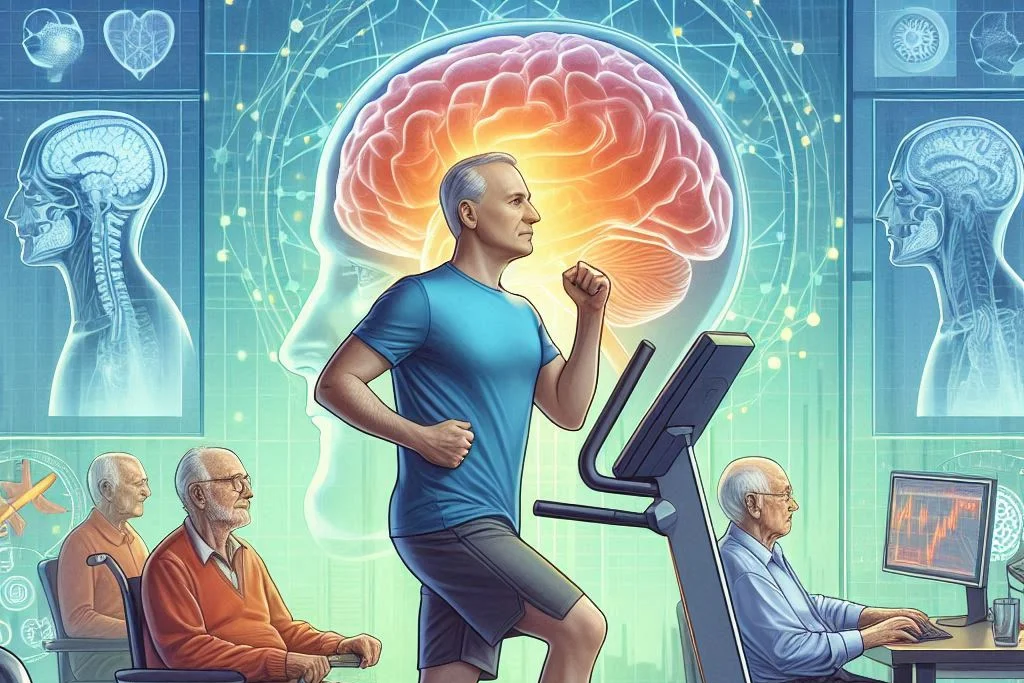Sweat Now, Remember Later: How Exercise Fights Alzheimer’s
Study shows aerobic exercise slashes Alzheimer’s biomarkers by 58-76%! See how regular movement protects your brain at the cellular level.

Research suggests consistent aerobic exercise may serve as a powerful tool for reducing biological markers linked to Alzheimer’s disease. A collaborative study conducted by scientists from the University of Bristol in the United Kingdom and the Federal University of São Paulo in Brazil observed a significant reduction in Alzheimer’s-related markers in laboratory rats following regular physical activity. These promising findings renew optimism regarding the development of effective strategies against this progressive brain disorder, indicating that exercise could play a role in protecting brain cells and restoring balance in aging brains.
Alzheimer’s disease, a condition marked by the gradual decline of memory, language, and cognitive function, currently has no known cure. Brain changes tied to the disease may begin years before symptoms emerge, emphasizing the importance of early preventive measures. Though lifestyle factors such as diet and physical activity have been investigated as potential preventive approaches, the growing number of Alzheimer’s cases highlights the limited effectiveness of existing treatments and prevention methods.
Identifying ways to prevent or delay Alzheimer’s remains a crucial public health priority. Ongoing research seeks to uncover risk and protective factors while developing reliable methods to assess dementia risk. Notably, mortality rates associated with Alzheimer’s continue to rise, diverging from trends seen in other major diseases such as heart disease and certain cancers. This concerning pattern reinforces the urgent need for more effective interventions.
For decades, the accumulation of amyloid plaques and tau tangles in the brain has been regarded as a defining feature of Alzheimer’s. However, these deposits alone do not fully account for the disease, as some individuals with such brain changes never exhibit symptoms. More recent investigations have shifted focus toward the deterioration of the myelin sheath—the protective layer surrounding nerve fibers—as a possible contributor to Alzheimer’s progression.
Evidence suggests that damage to myelin—the protective coating around nerve fibers—and the oligodendrocytes responsible for its production may occur even prior to amyloid and tau accumulation. Since oligodendrocytes contain high iron concentrations, their deterioration could release excess iron, potentially exacerbating amyloid-related issues. Additionally, disruptions in the brain’s chemical signaling systems might contribute to early Alzheimer’s development. Given the disease’s complexity and the multiple theories surrounding its progression, researchers are investigating various approaches to better understand and counteract its effects. This study specifically examined the amyloid, tau, and iron hypotheses, exploring how physical exercise might influence these factors in the brain.

This research holds particular significance for scientists who have observed Alzheimer’s impact on loved ones firsthand.
“Much time was spent with grandparents and other elderly individuals during childhood, fostering an early awareness of aging-related health concerns. Later, care was provided for elderly parents experiencing dementia, highlighting the challenges associated with cognitive decline,” shared study author Robson Campos Gutierre, director of the Almeria Institute of Integrative Science.
To investigate exercise’s potential benefits, a group of aged male rats—roughly equivalent to middle-aged humans—was utilized. Ten rats were divided into two groups: one undergoing an aerobic exercise regimen and another serving as a sedentary control. The exercise group completed an eight-week treadmill program, with sessions conducted five times weekly. Prior to formal training, a three-day treadmill familiarization period was implemented to minimize stress and ensure running capability.
Running ability was carefully evaluated, with only proficient runners included in the exercise group to isolate the effects of physical activity from stress-related factors. Training sessions incorporated a warm-up, followed by progressive increases in duration and intensity over the eight-week period. The control group was handled similarly—including placement on a stationary treadmill—to account for any environmental stress.
Following the intervention, brain tissue was analyzed using specialized staining techniques to assess Alzheimer’s-related markers in the hippocampus, a region vital for memory. Advanced stereological methods were employed to precisely quantify amyloid plaques, tau tangles, and cellular populations—including pyramidal neurons, granule neurons, oligodendrocytes, and microglia—ensuring accurate three-dimensional measurements of brain structures.
Significant differences were observed between exercised and sedentary rats in the study’s findings. Regular aerobic exercise was associated with substantial reductions in all key Alzheimer’s markers examined. Analysis revealed approximately 63% less tau tangle volume and 76% less amyloid plaque volume in the hippocampus of physically active rodents compared to the control group. Additionally, iron accumulation within oligodendrocytes showed a dramatic 58% reduction among exercised subjects.
Notable improvements in brain cell health were also documented. The population of healthy oligodendrocytes—critical for myelin production and nerve fiber protection—was found to be approximately double in exercised rats relative to sedentary counterparts. Conversely, oligodendrocytes exhibiting iron accumulation were reduced by half in the active group. Neuronal benefits were equally striking, with exercised specimens displaying about 2.5 times more unaffected pyramidal and granule neurons, while tau-affected neurons were reduced by a factor of four.
Microglial activity, an important indicator of neuroinflammation, was also examined. A significant decrease was noted in phagocytic microglia—those engaged in debris clearance—among exercised subjects. Multiple staining techniques confirmed fewer iron-laden microglia and reduced presence of microglia containing cellular debris, suggesting diminished inflammatory processes and cell death. Interestingly, non-phagocytic microglia populations showed moderate increases in the exercise group, potentially indicating a shift toward more neuroprotective functions.

Significant relationships between various brain measurements were revealed in the final phase of research. Exercise was found to enhance natural communication between neurons and oligodendrocytes while transforming the amyloid-iron relationship from negative to positive—indicating improved biochemical interactions within active brains. In sedentary specimens, negative correlations were observed between oligodendrocyte iron content and both non-phagocytic microglia and overall phagocytic activity. Conversely, exercised subjects demonstrated positive correlations between oligodendrocyte iron and phagocytic microglia, as well as between neurons and non-phagocytic microglia, suggesting exercise-induced restructuring of neural network dynamics.
“This investigation evaluated multiple Alzheimer’s-related factors in relation to physical activity. The preventive and therapeutic potential of exercise was confirmed through universally positive biomarker changes. Importantly, evidence suggests excessive iron accumulation in oligodendrocytes may contribute to Alzheimer’s-associated neural damage.”
Several study limitations were acknowledged. While aged rodents provide valuable insights into aging processes, they don’t perfectly replicate human Alzheimer’s pathology—particularly since the subjects weren’t genetically modified to develop disease-specific markers. Nevertheless, the findings offer compelling evidence about biological mechanisms likely conserved across mammalian species.
Future research directions include human clinical trials to examine whether aerobic exercise produces comparable biomarker improvements. Parallel investigations will explore pharmacological interventions targeting iron metabolism and cell death pathways—two processes significantly influenced by exercise that may represent promising therapeutic avenues.
“Long-term objectives include applying these statistical models to develop targeted drug therapies and optimized exercise protocols,” Gutierre noted. “It should be emphasized that dietary iron intake wasn’t measured—the observed iron likely originated from aged blood vessels releasing erythrocyte contents.”
https://doi.org/10.1016/j.brainres.2024.149419
Summary
Alzheimer’s disease (AD), a progressive neurodegenerative condition impacting memory and cognition, currently lacks a cure. Pathological brain changes may begin decades before symptoms emerge, highlighting the need for preventive strategies. Research suggests physical activity may counteract key AD markers, including amyloid plaques, tau tangles, myelin degradation, and iron accumulation.
This study examined aged rat hippocampi, quantifying tau, amyloid, iron, and ferroptosis (iron-dependent cell death) in oligodendrocytes. Statistical analysis revealed critical cellular interactions and the effects of exercise. Key findings include:
- Iron overload in oligodendrocytes triggers ferroptosis
- Physical exercise reduces inflammation and improves axon-myelin integrity
- Significant statistical correlations exist between tau, amyloid, iron, and hippocampal cells
- Exercised subjects demonstrated altered cellular crosstalk compared to sedentary counterparts
The results support physical exercise as a beneficial intervention for AD and provide mathematical models of hippocampal cell interactions that could guide future human and animal research.
